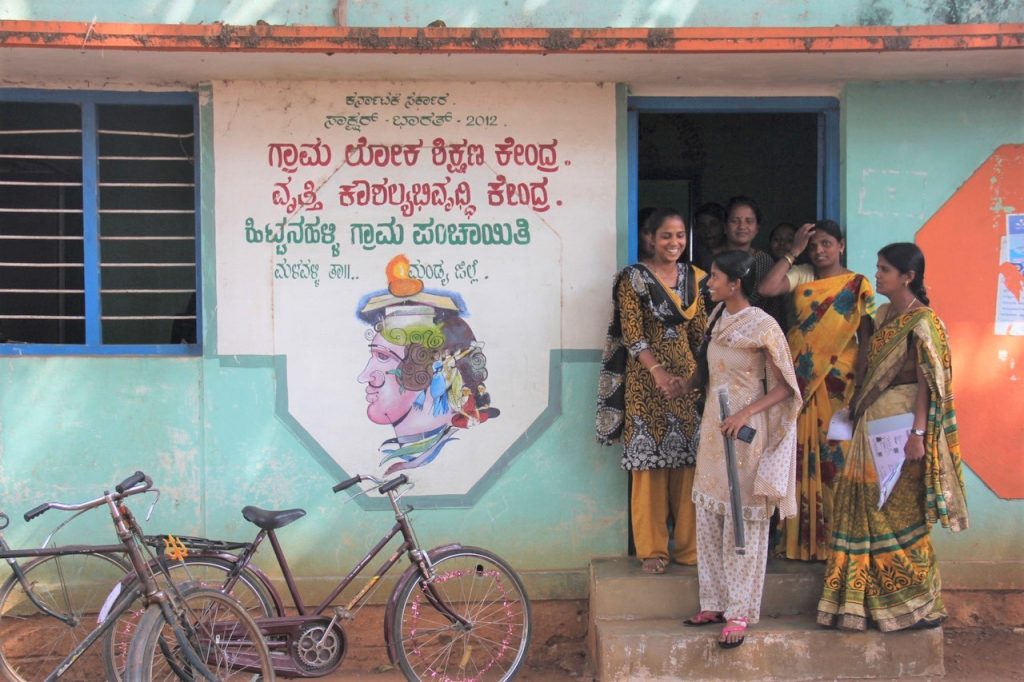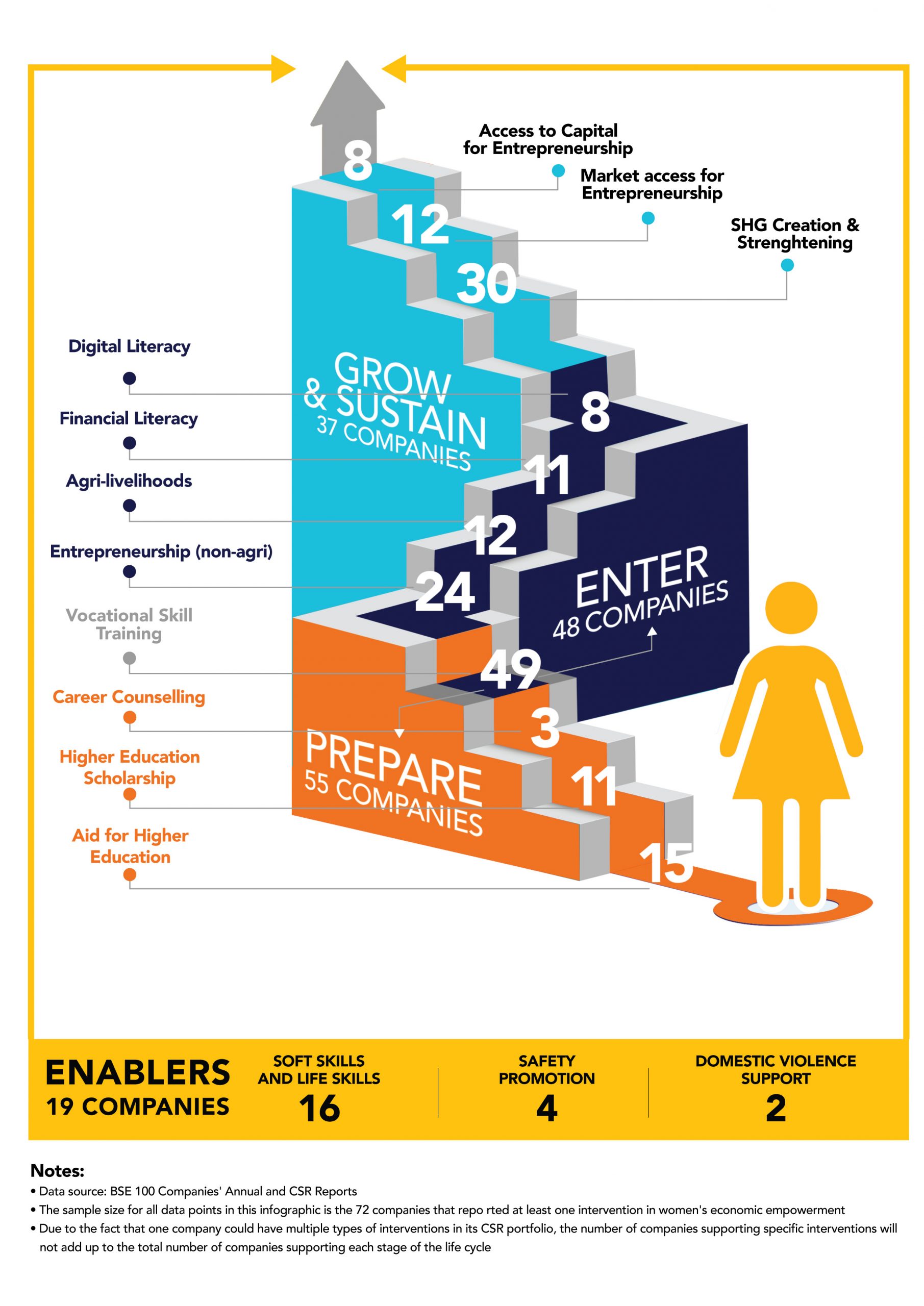Ranking at 127 out of 189 countries on the gender equality index in 2017, India does not provide a supportive environment in which women and girls can access their full potential. A number of demand and supply side barriers, underpinned by patriarchal attitudes and norms, keep them from education, employment, asset ownership, decision-making and ultimately, economic empowerment.
What do companies have to do with it?
The 2030 SDG Agenda acknowledges the corporate sector as a key partner to the achievement of the sustainable development goals (SDGs), including the achievement of gender equality.
In order to nudge companies towards a more gender transformative approach, the UNDP and our team at Samhita undertook a study to generate evidence on how India’s top 100 companies (as represented by the BSE 100 index) are currently supporting the cause, thereby highlighting the gaps, good practices, and the way forward.
Related article: CSR giving in India is heavily skewed
Our report presents a ‘continuum of responsible corporate citizenship’ through which companies can facilitate women’s economic empowerment, ranging from Corporate Social Responsibility (CSR) initiatives, to business practices such as supply chain and human resource management. In India, the role of the corporate sector has been further institutionalised via Section 135 of Companies Act, 2013, which made CSR mandatory for qualifying companies.
Topline CSR findings
Our analysis finds that while CSR interest in women’s economic empowerment is high—72 BSE 100 companies reported at least one CSR intervention related to the cause, the total expenditure is low—a cumulative of INR 250.62 cr across the 48 companies who reported this explicitly. This accounts for only four percent of total CSR expenditure.
As observed with overall CSR expenditure, the distribution of CSR support for women’s empowerment is not addressing areas that need it most. States with high need (as defined by the McKinsey Femdex), including Bihar, Jharkhand, and Assam, have seen very little CSR intervention.
What kind of support do women need?
The report defines a three-step, lifecycle approach that most women have to navigate to participate in the workforce—prepare, enter, grow & sustain. Each stage comprises of a set of interventions that help ease three of the four barriers to women’s economic empowerment as defined by the UN High Level Panel: adverse social norms, failure to recognise, reduce and redistribute unpaid care work, and lack of access to financial, digital, and property assets.
While CSR interest in women’s economic empowerment is high, the total expenditure is low.
Interventions range from scholarships, career counselling, and training in the ‘prepare’ stage; to placements, entrepreneurship, and financial and digital inclusion during the ‘enter’ stage; and access to capital, markets during the ‘grow & sustain’ stage. A set of ‘enablers,’ such as life skills training, behaviour change communication (BCC) with families and communities, and prevention of violence, cut across all three stages.
CSR support is concentrated in the ‘prepare’ (76 percent) and ‘enter’ (67 percent) stages, with less emphasis on the ‘grow & sustain’ stage (51 percent) and ‘enablers’ (26 percent).
Vocational training for women is the single most popular intervention supported through CSR, with 68 percent of companies reporting it. Self-help group (SHG) creation and strengthening follow at 42 percent companies, and entrepreneurship is also popular at 33 percent. Surprisingly, not many companies reported supporting digital and financial inclusion explicitly—11 percent and 15 percent—despite the presence of well-established and scalable models, and nonprofits working in these sectors. Of the 21 banking and financial services companies in the database, only six reported supporting financial inclusion.
Interviews with companies revealed that while a majority were aware of the importance of such initiatives, they are thwarted by practical challenges.
The ‘enablers’ also see low levels of support. Soft and life skills development—which are critical in building a women’s agency, equipping her to navigate power imbalances within her family, community and other institutions—were only reported by 22 percent. Safety promotion and domestic violence support interventions were reported by just four and two companies respectively.
Interviews with companies revealed that while a majority were aware of the importance of such initiatives, they are thwarted by practical challenges such as the complex nature of CSR decision-making within companies, difficulties in identifying evidence-backed and effective models and experienced partners, inability to quantify and measure outcomes, and inability to tackle perception of risks among internal stakeholders while engaging in sensitive subjects such as domestic violence.
CSR needs to join the dots
Of the 72 companies investing in women’s economic empowerment, the majority—61 percent—have interventions in only one or two components of the lifecycle. This indicates that companies are possibly working in silos and don’t address the inflection periods when women are most at risk of dropping out of the workforce. While it would be unreasonable to expect that any one organisation would have the resources or capabilities to address needs across the lifecycle, the framework provides a useful structure that puts women and their needs at the centre, around which companies can collaborate with other stakeholders.

India does not provide a supportive environment in which women and girls can access their full potential | Picture courtesy: Ragini Menon
Related article: Women and work: Examining India’s policy landscape
Turning scrutiny inward
While CSR is a good opportunity for companies to consider the impact they have on communities, they also need to consider the ways in which their own internal policies and processes impact women. As detailed in the UN Global Compact’s Women’s Empowerment Principles, the nature of corporate leadership, procurement practices, HR policies, and employee access to training and development support are all important to the achievement of gender equity at work.
Women make up less than 10 percent of the permanent workforce of the majority of BSE 100 companies.
Our study shows that women make up less than 10 percent of the permanent workforce of the majority of BSE 100 companies, possibly because industries that have historically been male-dominated, including manufacturing and automobile sectors, are very highly represented in this sample. Such occupational segregation is one of the most important factors limiting growth in women’s employment.
The study found examples of a few companies with gender-sensitive practices such as safe travel policies, flexible and/or remote working hours, programmes to enable new mothers’ transition back into regular work, development opportunities for women working in factories—all of which can be important determinants of whether women secure and stay in permanent employment.
Paying close attention to the grow & sustain stage
Increased representation of women in corporate leadership positions could have multiple positive impacts, ranging from higher profitability, to more innovative leadership as well as increased profits from innovation. Our study also indicates potential positive effects of women board members on comprehensiveness of CSR strategies for women’s economic empowerment.
Only six percent of companies reported having three or more women board members.
In keeping with mandatory requirements of the Companies Act, 2013, 98 percent companies reported having at least one woman board member, but more than half stopped there. Only six percent of companies reported having three or more women board members, which is the number studies suggest is needed for sufficient bargaining power in decision-making to avoid tokenism.
Related article: ‘Men-streaming’ women’s economic empowerment
Beyond board membership, increased representation of women in senior management is critical to creating an inclusive environment. Having more women at senior levels requires providing women with upskilling opportunities, resources, and mentorship. Almost half of BSE 100 companies did not publish any data on the proportion of women receiving skill upgradation training. Of those who did, only 26 provided this support to 75 percent or more of the women in their workforce.
Similarly, it was difficult to procure representative quantitative data to analyse gender inclusion in supply chains. In the absence of this data, our report presents select companies’ strategies to address gender parity in supply chains, including training and enabling women in rural areas to integrate into agricultural and fast-moving consumer goods (FMCG) procurement and distribution processes.
Increased accountability, reporting, and action at the grow & sustain stage is desperately needed for there to be a meaningful shift in women’s representation in corporate India.
The way forward
The corporate sector has a significant role to play in enabling women’s economic empowerment. Strategic CSR from companies with a long-term, lifecycle approach can catalyse impactful, measurable programmes. Adopting a gender lens across all business practices can result in more thoughtful and equitable inclusion of women in workforce. The study reveals many challenges faced by companies in their efforts to promote women’s economic empowerment and highlights the collective responsibility of the larger ecosystem to ensure that we create an enabling environment based on dialogue and shared values to support companies in their role in contributing to a more gender equitable India.








